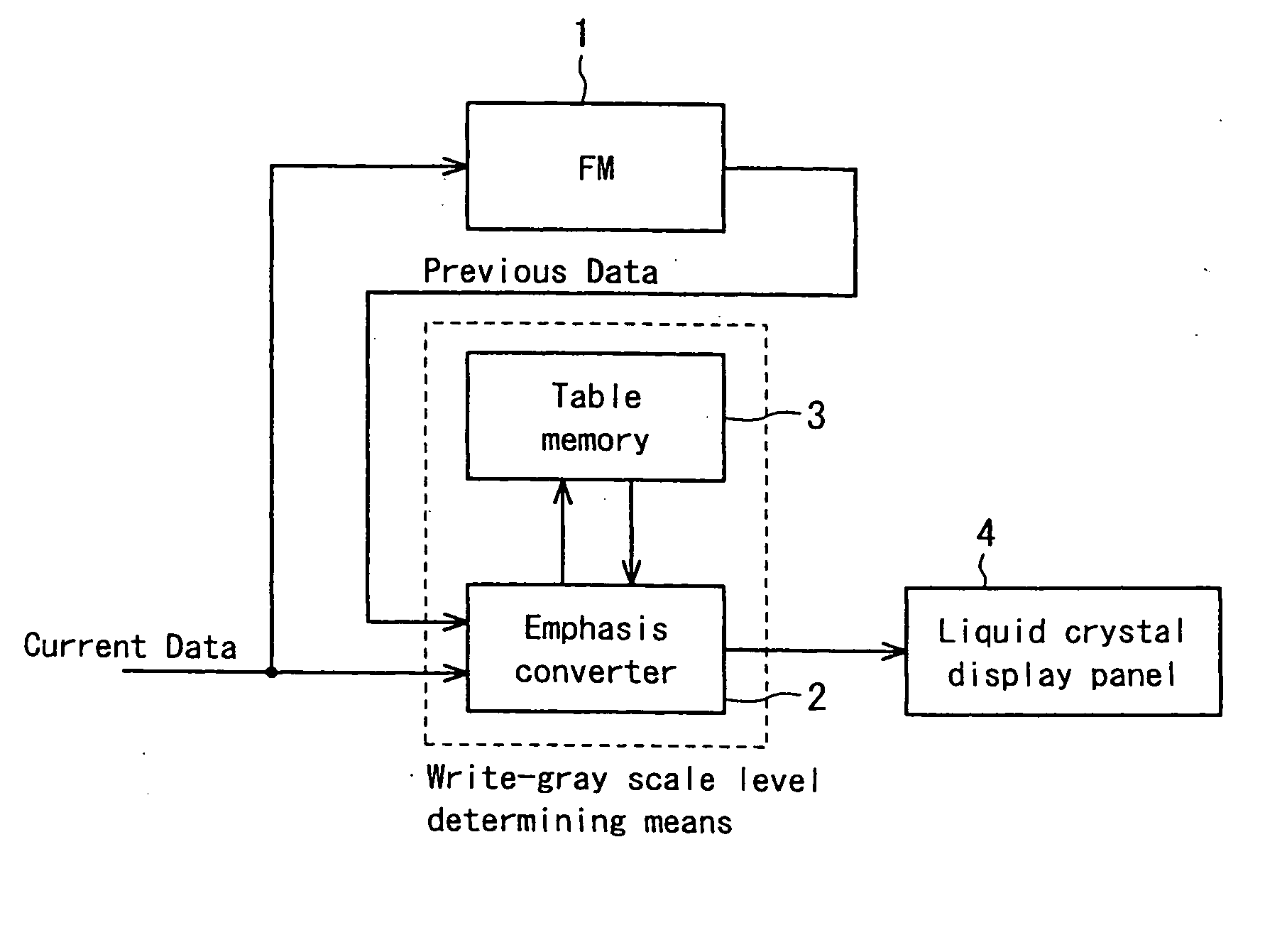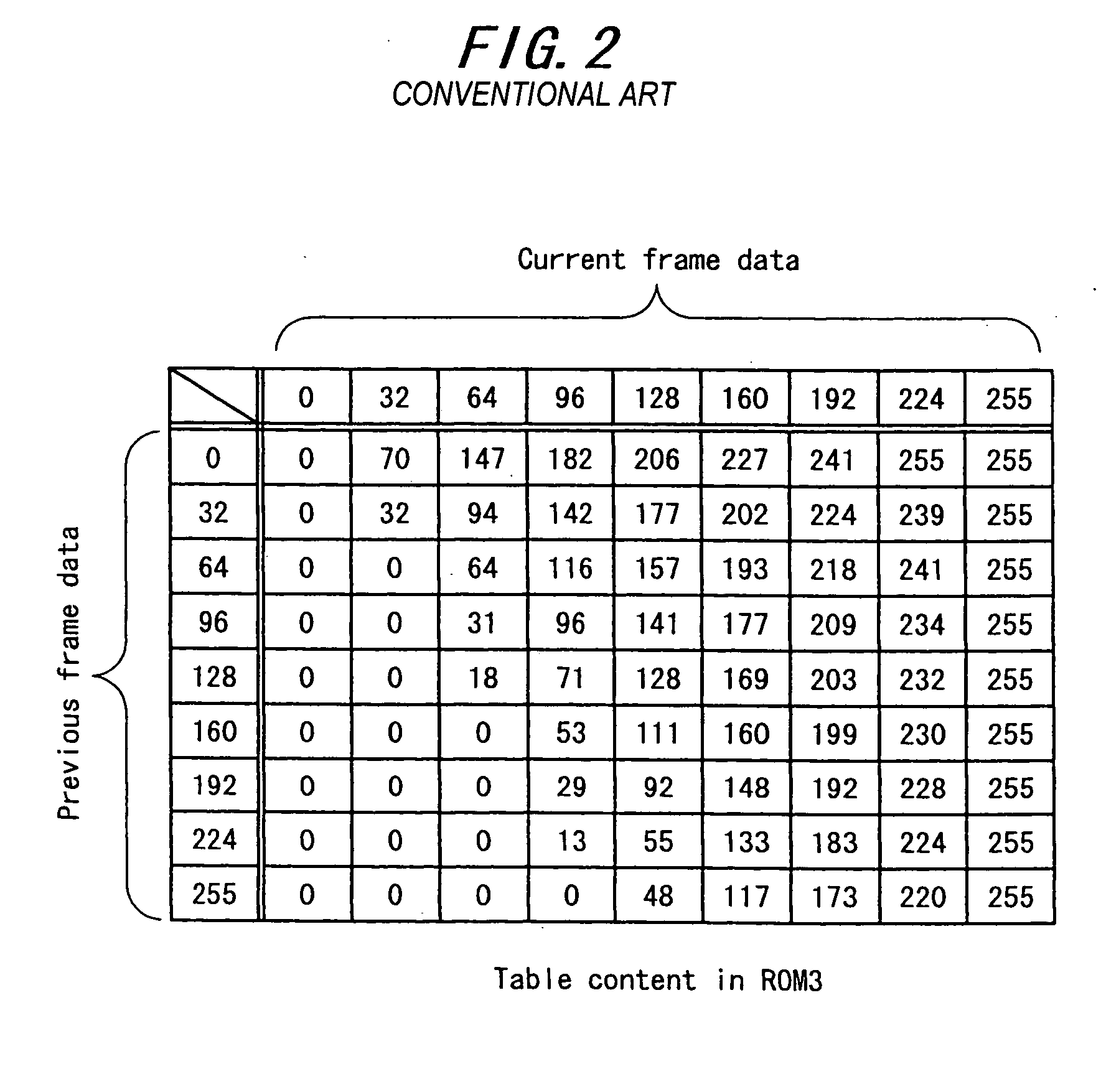Liquid crystal display
a liquid crystal display and display panel technology, applied in the field of liquid crystal display, can solve the problems of low response speed, difficult to reproduce motion pictures, and inability of a general liquid crystal display panel to display half gray scales within a period of one frame, so as to prevent image degradation of the display image, and improve the image quality of the display image
- Summary
- Abstract
- Description
- Claims
- Application Information
AI Technical Summary
Benefits of technology
Problems solved by technology
Method used
Image
Examples
first embodiment
[0078] Now, the present invention will be described in detail with reference to FIGS. 7 to 10. Here, FIG. 7 is a block diagram showing a schematic configuration of essential components in a liquid crystal display of this embodiment; FIG. 8 includes schematic illustrative charts, showing table contents in ROMs in the liquid crystal display of this embodiment; FIG. 9 is an illustrative diagram showing the relationship between the detected temperature and the level at which the emphasis conversion parameter is switched in the liquid crystal display of this embodiment; and FIG. 10 is a flowchart showing a hysteresis process in the liquid crystal display of this embodiment.
[0079] In FIG. 7, 1 designates a frame memory (FM), 3 a table memory (ROM) storing emphasis conversion parameters in accordance with gray scale level transitions of input image data, 52 an emphasis converter which, by comparing the current frame image data with the previous frame image data read out from FM1 and readin...
second embodiment
THE SECOND EMBODIMENT
[0092] Next, the second embodiment of the present invention will be described in detail with reference to FIG. 11. Here, FIG. 11 is a flowchart showing a hysteresis process in the liquid crystal display of this embodiment.
[0093] The configuration of the liquid crystal display of this embodiment is identical with that of the first embodiment described above with reference to FIG. 7. The point of difference is in the hysteresis process in microcomputer 38, so description will be made as to this particular point with reference to the flowchart in FIG. 11.
[0094] First, the temperature data from thermistor 37 is acquired (Step S11). The current LEVEL for the emphasis conversion parameters corresponding to the obtained temperature data is determined (Step S12). The thus determined current LEVEL is compared with the determined LEVEL for the emphasis conversion parameters having been selected (Step S13). If both are equal, both the counter values on the up-counter and d...
third embodiment
THE THIRD EMBODIMENT
[0105] Next, the third embodiment of the present invention will be described in detail with reference to FIGS. 13 and 14. The same components as those in the conventional example are allotted with the same reference numerals and description for those is omitted. Here, FIG. 13 is a block diagram showing a schematic configuration of essential components in a liquid crystal display of the present embodiment. FIG. 14 includes schematic illustrative charts showing the table contents in table memories used in the liquid crystal display of the present embodiment.
[0106] This embodiment, as shown in FIG. 13, includes four temperature sensors 16a to 16d each detecting the panel temperature of different divided areas of a liquid crystal display panel 4, equally divided into four image areas. Here, the number of area divisions of liquid crystal display panel 4 is not limited to four, but obviously, the whole area may be equally or unequally divided into two or more areas eac...
PUM
 Login to View More
Login to View More Abstract
Description
Claims
Application Information
 Login to View More
Login to View More - R&D
- Intellectual Property
- Life Sciences
- Materials
- Tech Scout
- Unparalleled Data Quality
- Higher Quality Content
- 60% Fewer Hallucinations
Browse by: Latest US Patents, China's latest patents, Technical Efficacy Thesaurus, Application Domain, Technology Topic, Popular Technical Reports.
© 2025 PatSnap. All rights reserved.Legal|Privacy policy|Modern Slavery Act Transparency Statement|Sitemap|About US| Contact US: help@patsnap.com



